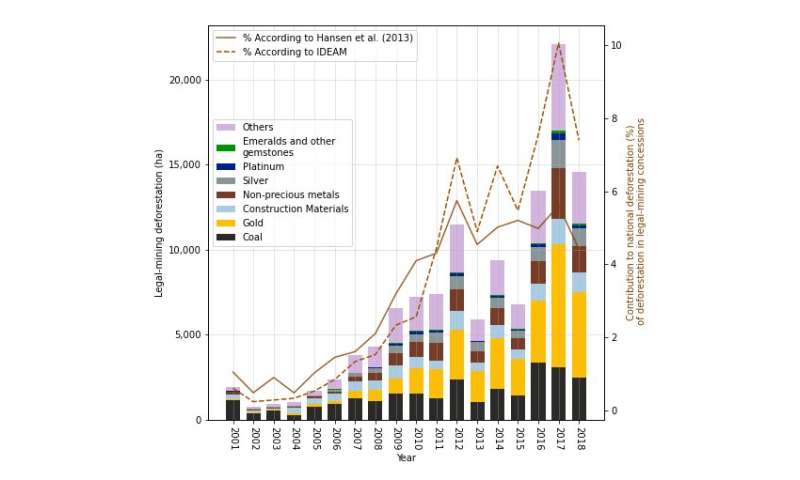Legal mining increasingly ravages forests in megadiversity hotspot

Colombia is the second most biodiverse country in the world and around half of its land territory is forest-covered. Deforestation is one of the biggest worldwide threats not only for biodiversity but also for climate. In fact, removing trees by burning them or then letting them decompose in their entire life cycle, leads to massive carbon dioxide release currently reaching up to 10–15% of all the human greenhouse gas emissions.
In the tropics, cutting trees is mainly driven by agricultural expansion, land grabbing, illegal logging, urbanization, cattle ranching as well as mining. Those drivers depend on socio-economic and political factors. In Colombia, an important worldwide producer of minerals, mining concessions have been granted across more than 3% of the continental territory (more than 8,000 mines), potentially affecting water use and quality, chemical flows to water and soils, health and human rights impacts but also forests. However, there is a global lack of studies that analyze the environmental impacts of legal mining, particularly in areas of high biodiversity.
For the first time, a new study I co-authored published in Environmental Research Letters shows that deforestation rates in Colombian mining leases each year have exponentially increased in the last two decades (see Figure 1, bars indicate mining-related deforestation from ~2000 ha in 2001 to more than 20,000 ha in 2017). For instance, in the department of Antioquia, a massive gold producer, 23% of the departmental deforestation occurred in legal mines.
Ravaging clear cuts are particularly observed in one hundred mines where more than 400 ha are deforested per mining concession, the equivalent of >500 soccer fields each. Less clear are the reasons behind this mining-related deforestation increase because gold and coal production did not vary much during the same period. Two main reasons can be put forward: (i) massive commercial logging and (ii) illegal external activities related to armed conflict.
Peace for some regions, war on forests
After the ratification of the peace agreement between the Colombian government and the FARC guerilla in 2016, large increases in gold- and coal-related deforestation are observed (yellow and black bars, respectively). Indeed, after FARC demobilization, vacui of territorial power were left, leading several groups (armed or not) to intervene in those old-conflictual zones, including some legal mining sites.
Given that in Colombia, several illegal armed and non-armed groups are still operating, it is not uncommon that informal agreements are made between the concessions' owners and these groups to let them perform mining or logging activities. Criminal dimensions in the mining sector have necessarily to be considered.
Deforestation undermines carbon footprint of the mining sector
Without actions to counteract deforestation in mining leases, supposing that all newly requested mining titles would be granted (at February 2019, corresponding to 8.56% of the Colombian land territory, according to the National Mining Agency, 2019), they would add up approximately ∼400,000 ha of new legal mining zones over two decades.
Some good news? Half of the mining in Colombia deforests less than 1 ha. Thus, generalizing those good practices of deforesting less than 1 ha for each mining lease would reduce the deforestation associated to legal mining by more than 90% the legal mining sector deforestation footprint. Reforestation should be systematic if deforestation cannot be avoided in agreements with national institutes and regional environmental institutions.
Finally, accounting for carbon emissions due to deforestation in Colombian legal mines would add up ∼1/3 to the greenhouse gas emissions of the mining industry sector over the entire 2001–2018 period. To fight climate change efficiently, Colombia should crucially address this matter in the framework of its recently ambitious climate mitigation goal which aims for a 51% emissions reduction by 2030.
This story is part of Science X Dialog, where researchers can report findings from their published research articles. Visit this page for information about ScienceX Dialog and how to participate.
More information:
Andrés González-González et al, Growing mining contribution to Colombian deforestation, Environmental Research Letters (2021). DOI: 10.1088/1748-9326/abfcf8
Bio:
Prof. Dr. Benjamin Quesada (M) is climatologist, professor at Universidad del Rosario (Bogotá) and co-leader of the Earth System Science program. He holds a PhD in Meteorology, a MS in Climatology and a BS in Mechanical Engineering with a minor in Environmental Engineering. His research primarily focuses on: land-atmosphere interactions, temperature extremes, land-cover change impacts on climate and ecosystem functions and terrestrial carbon cycle. Since 2011, he has published 20 peer-reviewed publications in a diversity of journals on those topics. He is also Contributing Author of the IPCC Special Report on Climate Change and Land (SRCCL, Chapter 2 "Land-Atmosphere Interactions", 2019) and of the recent Intergovernmental Science-Policy Platform on Biodiversity and Ecosystem Services (IPBES) Global Assessment report (Chapter 4 "Plausible futures of nature, its contributions to people and their good quality of life", 2019).